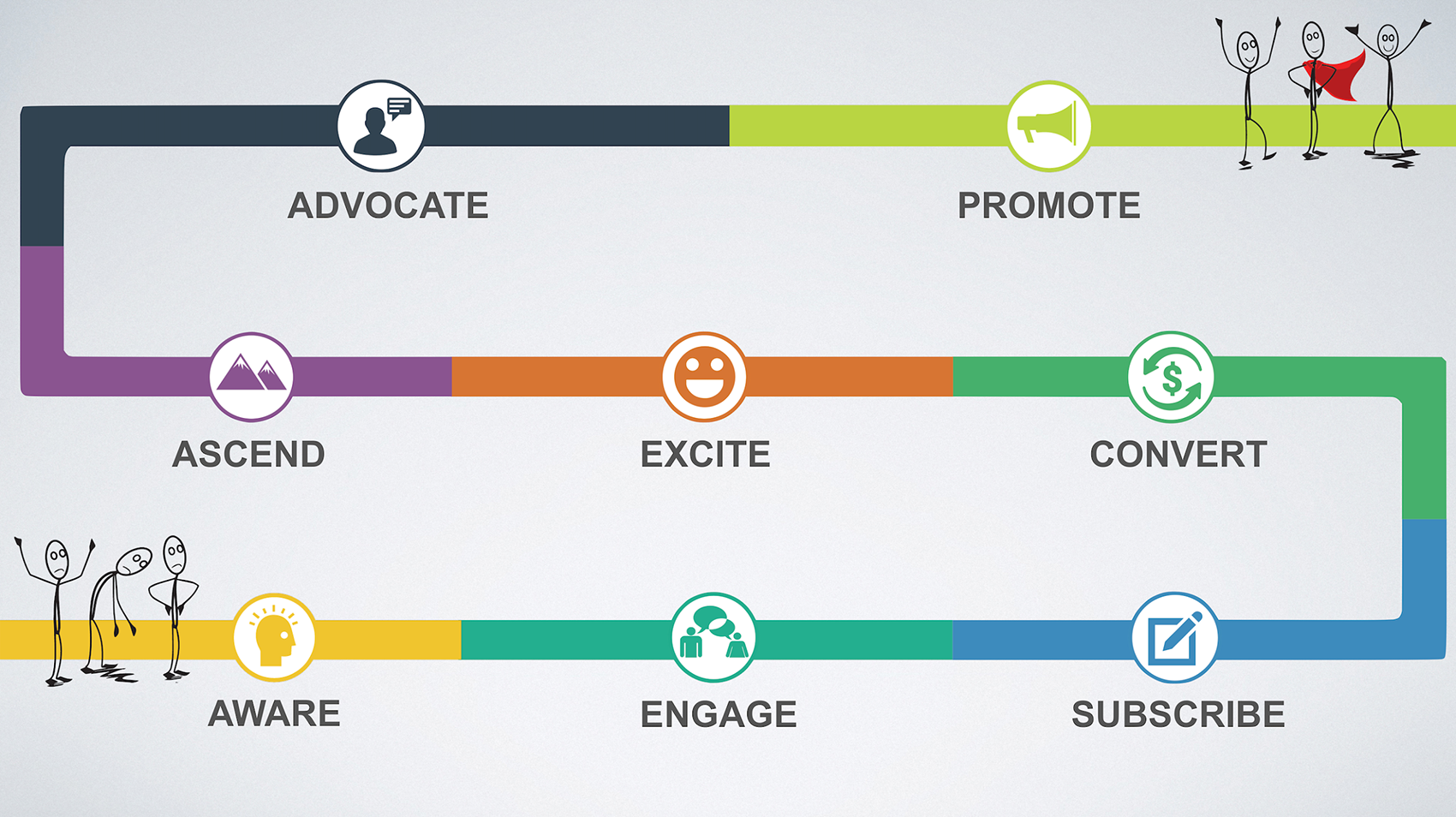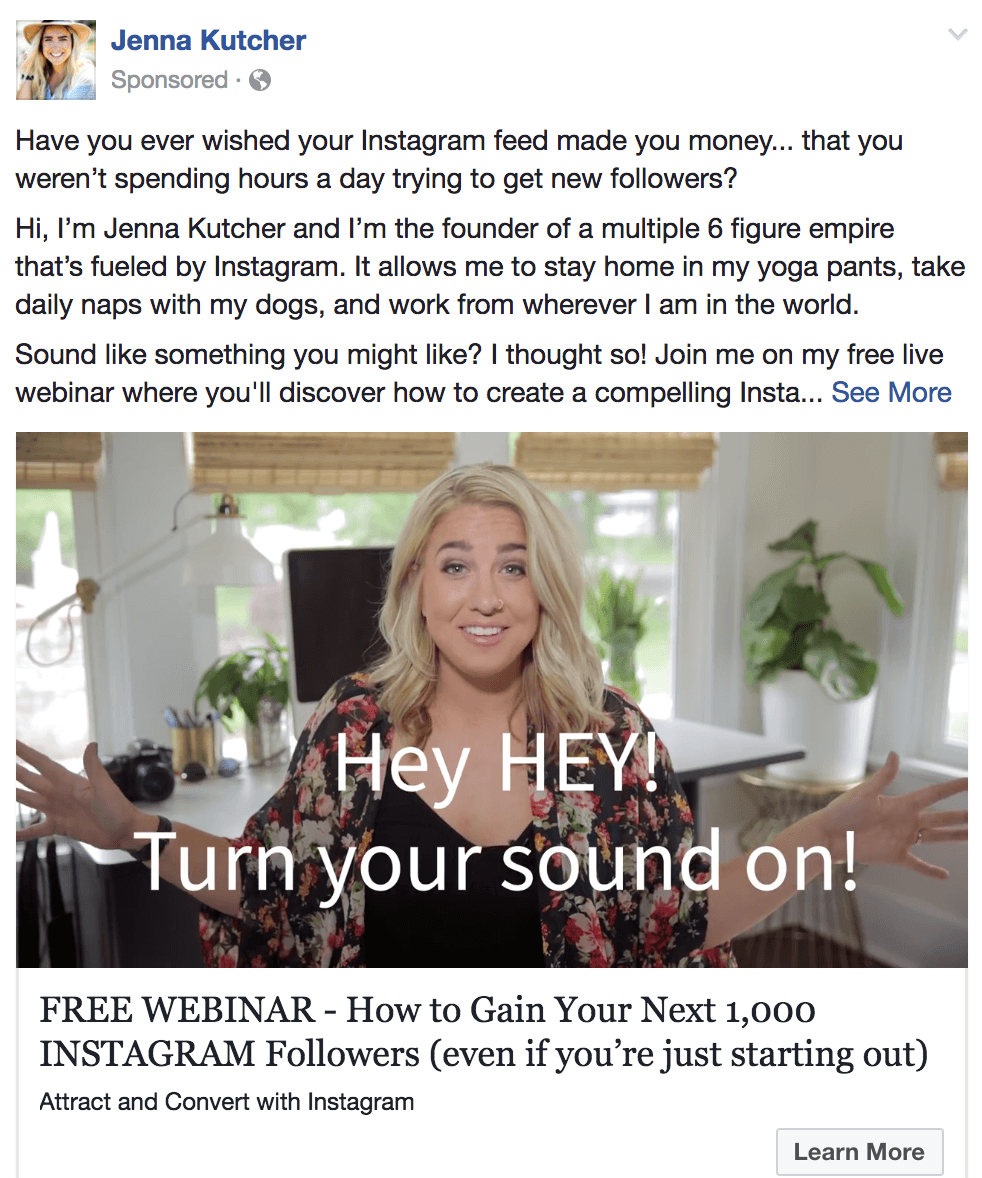The hardest part about getting new customers is getting their attention.
With so much noise on the internet competing for their interest, it’s crucial that businesses find a way to make their message heard.
But after you actually gain their awareness, the second hardest part is keeping it.
Once your customer begins their adventure with your business, it’s vital that you both keep your brand in their minds and continue building the relationship you set out to create….
…and you do that through engagement.
But before we get into that, let’s recap The Customer Value Journey.

The Customer Value Journey is the 8-stage adventure your customer goes on that transforms them from a complete stranger to your brand into a total evangelist for it.
Engagement is the second stage. At this point, customers are aware that you exist. They’ve seen a Facebook ad, found you in a Google search because of SEO or heard about you from a friend.
But now you have to successfully take them from Awareness to Engagement by getting them actively involved with your content, guiding them to evaluate your brand and see if it’s actually for them.
Based on where they are right now in the journey, most of this happens on your website. They might watch a video, read a blog post, browse products or read more about your business.
The kind of content you post and its quality will determine whether they take the step of giving you their email address to get a lead magnet and find out more…
…and that will determine whether they continue to travel through the Value Journey you’ve built for them.
But here’s the kicker…
Engagement doesn’t just happen in the second stage in the Journey.
In reality, it’s an essential technique that continues through your entire lifetime interaction with your customers.
Why Engagement Matters Beyond The Engagement Stage

Engagement is all about exchange—giving audiences an action to take and watching how they respond.
Part of the reason the Customer Value Journey is such a successful model is that it builds a relationship through micro commitments.
You can’t expect people who have never heard of you to drop the cash for your core offer immediately…
…but ask them to take small steps—like downloading a lead magnet, investing in a tripwire offer or reading a blog post—and you increase the likelihood that they’ll eventually do it.
The more small actions they take, the more value they discover from your brand…which means you build the trust and authority necessary to make them into repeat customers.
Since good marketing follows the natural course of human relationships, let’s use a relationship analogy.
Imagine that two people meet…go on dates, build a relationship and eventually get engaged.
They plan an amazing wedding, build excitement and anticipation for it, tie the knot and celebrate on the big day, leave for an epic honeymoon….
…and then never talk to each other again.
Sound ridiculous? It should. And if it doesn’t…you probably haven’t had many successful relationships.
Marketing works the same way. You shouldn’t stop “dating” your customers just because they ascended to the level of promoters for your business and completed their adventure.
You need to continually create content that engages them, creates an ongoing experience and keeps them involved with your brand.
Otherwise, they’ll eventually forget about you and go somewhere else.
According to one survey…the biggest reason customers leave one business for another is that they feel like the company doesn’t care about them.
If this happens…it means you’ve stopped focusing on their needs and started relying on them purely as a tool to make a buck…which, quite frankly, makes you a scam.
You must keep customers engaged and involved so they will remain enthusiastic, continue to find value in what you do and most importantly, keep telling other people about you.
How do you create this kind of immersive, exciting interaction?
We’ve got 6 ways to engage customers so they keep coming back.
How To Engage Customers No Matter What Stage In The Journey They’re On
Make Ads Interactive

You don’t have to wait until the Engagement stage itself to begin asking customers for micro commitments. One of the most important things you can do in the Awareness stage is get them involved.
Your Facebook ads don’t have to be passive, with simply a picture of your product, a few clever lines of copy and a call to action button. They can inspire your customers to immediately take action.
One to do this is by creating a video ad with a command to viewers to turn their sound on.
Most Facebook users scroll their newsfeeds with the sound off. Having them turn on the sound to view a brief video not only is a way to get them to see your content to the fullest extent…
…it also gets them to take a small action that will prime them for additional actions as they move through the journey.
Gamify Your Website
Gamification means using the interactive elements of games in a non-game context…things like your website and brand promotion.
Like Facebook ads, passive displays of content on your website won’t get you anywhere. Engagement is all about creating a memorable experience, and integrating interactive gaming into your marketing will go a long way to keeping your old customers and getting new ones.
For example…creating a Choose Your Own Adventure game on your website to introduce your product or service through a first-person scenario that has different outcomes depending on the choices your customer makes.
Apart from using the game to get new customers, you can also create new adventures for established customers to play through as a way to introduce new products or services.
Have A Contest

Contests are an engagement tool that work throughout all stages of the Value Journey. People might not be ready to purchase at the engagement stage, but they might be willing to enter to win a free product.
Contests don’t have to stop at the beginning of the journey, though. They’re also a great way to get people who have reached the end of the journey to promote your brand by giving referrals.
Hold a contest for current customers to refer other people, and the customer who has the most referrals convert to buyers receives something of high value from your company.
It keeps people at all stages of the journey involved and continues to remind them of why they invested in your brand to begin with.
Become A Social Media Genius
One of the biggest ways to engage customers is to stop looking at social media as a place to post ads and inspirational quotes and start using it as the ultimate hub for customer engagement in any stage of the journey.
When people follow you on social media, they don’t do it just so they can add you to their list of favorite things.
On a larger level…they do it because they expect you to engage with them.
So if you post content that talks all about you and doesn’t present value to them, you’re missing a major chance to invest in both new and existing customers…
…not to mention create more awareness.
Social media isn’t just a platform. It’s a secret engagement weapon.
One strategy is to solicit feedback about your products from customers, then analyze that feedback for trends on how to optimize what you do.
If you see dialogue unfolding in the comments section of posts that points to a particular action you could take to make your product better, you can show your audience you are listening by actually taking that advice.
Another way to engage with social media users is through messenger bots. You can install a bot on your Facebook page and website that allows users to communicate with you through pre-programmed drip messages on Facebook Messenger.
With the majority of people preferring to communicate with text messages, especially when it comes to customer service, messenger bots are a powerful tool to give basic information about your brand and provide a way for people to ask questions.
Segment Your List
Segmentation is a tool to take automated marketing and engage customers at all stages by making your message more personal.
Rather than speaking generally to all your customers, it lets you specifically direct your messaging to groups of customers who fit into particular categories.
For example, you can group customers by actions they’ve taken, like downloading a resource or making a purchase, or the stage of the Value Journey they are in.
You can even create categories to contact people by location and demographic traits. The point is that the more personalized your email interactions are, the more likely customers are to continue engaging with you.
Make Them Advocates & Promoters
Successful, satisfied customers love to share their stories…but sometimes they need a little push to do it.
And that motivation comes through engagement.
We’ve already discussed contests at this stage and how they can encourage customers to engage by giving referrals. But it doesn’t have to be a contest.
Just directly talking with your customers who have completed the journey can engage them enough to keep promoting your brand.
For example, contact your regular customers by phone or email and offer them a gift card or financial incentive to write out or film their testimonials for you to use.
The beauty of this method of engagement is that you can take their testimonials and repurpose them as social media and web content…
…ultimately inspiring current and soon-to-be customers to engage even more.

Want to explore how to put these ways to engage customers to work and find out about even more strategies?
Our Double Your Sales Review will teach you 73 ways to grow your business and hit your 12 month goals.
This complimentary strategy session will equip you with tools and resources you didn’t even know about so you can create even more powerful engagement with customers.
Click here to learn more and grab some time on our calendar!
